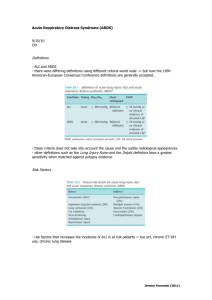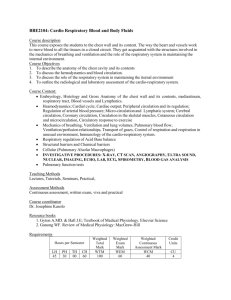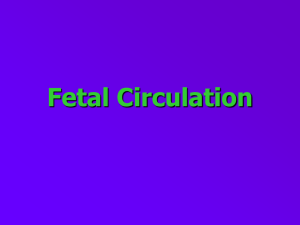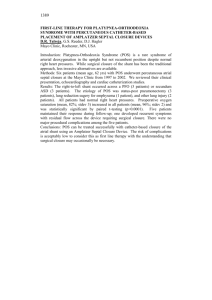Physiology - Adaptation of the Newborn to Extra
advertisement
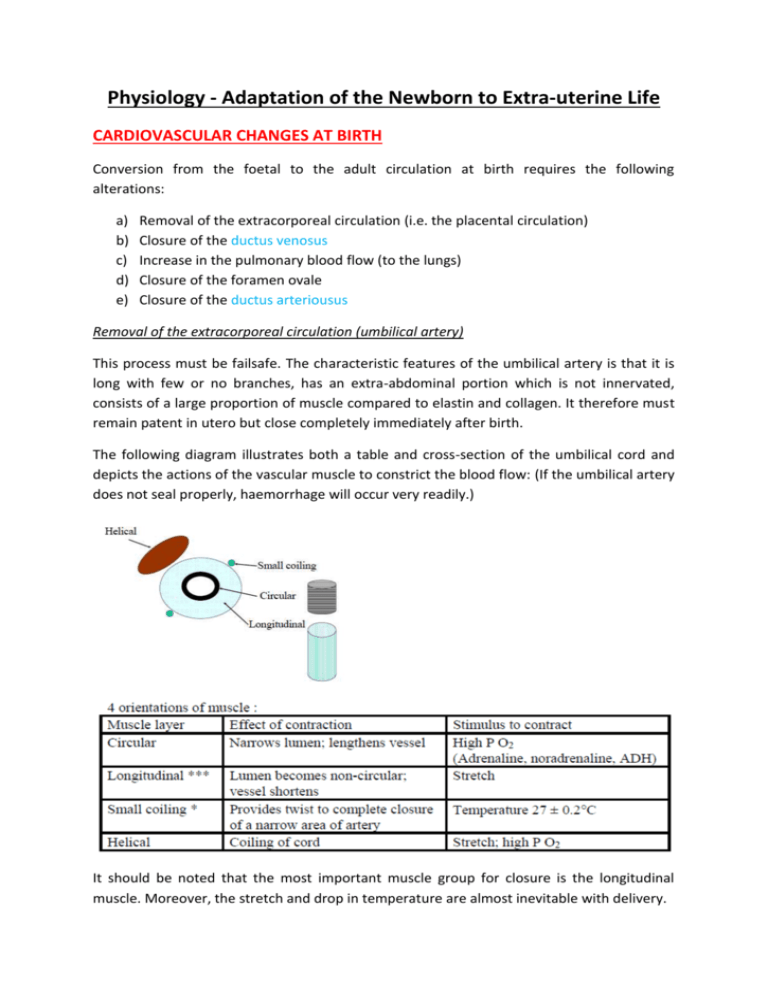
Physiology - Adaptation of the Newborn to Extra-uterine Life CARDIOVASCULAR CHANGES AT BIRTH Conversion from the foetal to the adult circulation at birth requires the following alterations: a) b) c) d) e) Removal of the extracorporeal circulation (i.e. the placental circulation) Closure of the ductus venosus Increase in the pulmonary blood flow (to the lungs) Closure of the foramen ovale Closure of the ductus arteriousus Removal of the extracorporeal circulation (umbilical artery) This process must be failsafe. The characteristic features of the umbilical artery is that it is long with few or no branches, has an extra-abdominal portion which is not innervated, consists of a large proportion of muscle compared to elastin and collagen. It therefore must remain patent in utero but close completely immediately after birth. The following diagram illustrates both a table and cross-section of the umbilical cord and depicts the actions of the vascular muscle to constrict the blood flow: (If the umbilical artery does not seal properly, haemorrhage will occur very readily.) It should be noted that the most important muscle group for closure is the longitudinal muscle. Moreover, the stretch and drop in temperature are almost inevitable with delivery. Closure of the umbilical vein and ductus venosus Both the umbilical vein and the ductus venosus are thin walled and close passively (this means as the blood flow through them ceases, the lumen thus collapses). There is no issue with retrograde flow. The permanent closure of the DV occurs in most newborns at about 3 months. Increase in pulmonary blood flow When the baby takes its first breath, air replaces the fluid in its lungs. When delivered, lung liquid is expelled, some is deposited into the blood and some is removed by the lymphatics. The expansion of the alveoli with the air causes the “uncoiling” of the pulmonary vascular bed and high PO2 of air causes dilation of the pulmonary vasculature (which the fall in PCO2 may also contribute to). Therefore, the pulmonary vascular resistance falls and the pulmonary blood flow increases by about 8-10 fold. (The increased oxygen leads also to the production of PGs and NO which mediate vasodilation.) Closure of the foramen ovale The 2 key factors that contribute to its functional closure is: i) ii) As the umbilical flow ceases, the venous return via the inferior vena cava decreases. Therefore the stream of blood tending to keep the foramen ovale open is removed, and the valve tends to fall back onto the crista dividens. The increase in pulmonary blood flow after the baby has first breathed causes and increase in pulmonary venous return and therefore an increase in blood flowing into the left atrium. This further allows closure of the valve. However, despite being functionally closed, anatomical closure may take up to a year or longer, and in 10% of adults, a probe may be passed through it. Closure in the ductus arteriosus The fall in pulmonary vascular resistance and the rise in the systemic vascular resistance (because of the loss of placental circulation) induces the flow through the DV to reverse. This means the blood flows from the aorta into the pulmonary artery. Humans have high incidences of left to right shunt in the 1st hour after delivery and may be advantageous to the newborn (why?). The circulation – almost adult except for the left to right shunt in the DA – is called the transient or neonatal circulation. It persists for as long as the DA remains open and the pulmonary vascular resistance is less that the systemic vascular resistance. It may last for minutes to hours. This illustration highlights the changed form of the circulation of a newborn: The constriction of the DA stops this reversed flow, and then the circulation is converted to an “adult” circulation with 2 ventricles pumping in series. The stimulus for close of the DA is a high PO2. Moreover, after closure hypoxia may result in re-opening. Adrenaline may cause the DA to re-open but only if high concentrations of O2 are present. Prostaglandins (esp. Prostacyclin) are important for maintaining patency in utero. The inhibition of prostaglandins (such as indomethacin) may cause premature closure. These drugs are used therapeutically to close the DA in neonates. The closure may be necessary as persistent DA can cause pulmonary hypertension. Eventually the high pulmonary pressures induces the right to left shunting and cyanosis. Anatomical obliteration generally occurs by the end of the 1st year post-partum. Gradually over the first year the wall of the left ventricle becomes thicker than the wall of the right ventricle (i.e. adult ventricular weight relationships are reached). In utero, the ventricles are similar thickness in walls. However in adulthood the left ventricle is thicker than the right ventricle. RESPIRATORY FUNCTION AT BIRTH The lungs need to be able to function after birth (as the blood is no longer oxygenated by the placenta). (i) Surfactant. For gaseous exchange, the alveoli need to be inflated and remain open. This requires surfactant, which acts as a detergent, to reduce surface tension. Surfactant consists of phospholipds (90%) and proteins (10%). The enzymes necessary for surfactant synthesis are in fetal lungs from 18-20 weeks onwards, but maturation of surfactant production occurs mainly in the last 4 weeks (i.e. from week 36). Surfactant is produced by the Type II alveolar cells. Production is stimulated by cortisol. In premature infants, insufficient surfactant production means that greater respiratory effort is necessary for lung expansion. Respiratory distress syndrome (hyaline membrane disease) may result. Because of this, if premature labour seems unpreventable, corticosteroids are given to the mother in an attempt to mature the lungs prior to birth. Giving surfactant postnatally has greatly reduced neonatal mortality and RDS. Natural surfactants (derived from animals) seem to be more effective than synthetic surfactant, presumably because they contain surfactant proteins. Synthetic surfactants just contain phospholipids. Animal based surfactants are now used as they also contain a protein that aids the spreading of the surfactant. (ii) The newborn needs to breathe regularly and continuously. In utero the fetus practises breathing movements but these movements are episodic. Stimuli causing the first breath after birth - tactile, fall in temperature, auditory, visual, gravitational, noxious. i.e. basically an increase in general arousal. As well, elastic recoil following release of thoracic compression during birth, asphyxiation and increased chemoreceptor sensitivity and release from facial immersion may contribute. For the first breath negative intrathoracic pressures of up to 70 cm H2O may be generated (more often -30 to -50). With this and subsequent breaths, air becomes progressively trapped in the lungs forming the functional residual capacity. Subsequent breaths require less pressure. Instability of breathing control is particularly a problem in premature infants --> episodes of apnea. Sudden infant death syndrome may be related in some cases to immaturity of control of breathing. (iii) The surface area for gaseous exchange needs to be adequate. This is not generally a problem after 26 weeks of gestation except in exceptional circumstances e.g. diaphragmatic hernia. MAINTENANCE OF BODY TEMPERATURE The newborn human can have difficulty maintaining body temperature because: (a) has a limited ability to shiver (also can't sweat) (b) can't exercise to keep warm (c) can't move to a warmer area (d) can't decide to put on a jumper, have a warm drink etc. (e) has a large surface area to body weight ratio (thus radiant heat loss is high) (f) doesn't have a thick layer of subcutaneous fat to insulate it (human neonate 75% water cf. adult 60% or less) (g) is wet following delivery (thus evaporative loss is high). The main mechanism it can use to produce heat is chemical thermogenesis (non-shivering thermogenesis) i.e. heat production by the oxidation of brown fat. Brown fat is found between the scapulae, behind the sternum, in the nape of the neck and around the kidneys. Brown fat cells have a central nucleus, multiple fat vacuoles, many mitochondria and are supplied by sympathetic nerves. β receptor stimulation activates the breakdown of triglycerides to free fatty acids and glycerol. Free fatty acids are oxidized in the mitochondria but instead of generating ATP by oxidative phosphorylation in the flavoprotein-cytochrome system, there is uncoupling of metabolism and ATP production so that more heat is produced. Heat production begins at a higher skin temperature in infants than in adults. However, since the neonate cannot retain the heat, it is inefficient and uses up a lot of energy. Other factors that maintain thermoregulation are vasoconstriction of peripheral regions of the body. Moreover by maintaining a foetal posture, thermal conservation may also be maintained. Cold stress increases neonatal mortality. It can lead to decompensation if the neonate has other problems e.g. cardiac, respiratory. Temperature maintenance is particularly a problem for the premature: (a) their thermoneutral zone is higher (it decreases with postnatal age) [it is the temperature range where the body can maintain easily a normal body temperature] (b) they have less fat stores (c) they have higher surface area to body weight ratio. Therefore these babies are kept in the controlled environment of incubators which minimize heat losses. This environment should be enclosed, double walled, warm and moist. NEONATAL NUTRITION Before birth, the fetus has a continuous infusion of glucose, amino acids and fatty acids from the mother. In the last trimester: (a) Glycogen stores are laid down – skeletal muscle ,liver, muscle, heart (10x normal adult – hypoxic heart still has glucose to use), lungs and adipose tissue - stimulated by cortisol. Expressed per 100g of wet tissue, cardiac and skeletal muscle glycogen stores are 10 and 3.5 times adult levels. (b) Induction of liver gluconeogenic enzymes. Also stimulated by cortisol. Gluconeogenic enzymes are present in the human liver by 4 months gestation. Phosphopyruvate carboxylase activity is only 10 % of adult activity in the term neonate, but then increases rapidly. If premature, there are less gluconeogenic enzymes at birth. (c) Fat stores are laid down (560 g at term). This process starts at about 32 weeks gestation. These stores of glycogen and lipid need to be utilized until adequate milk intake is achieved. After birth, glucagon levels are high, insulin levels are low and catecholamine levels are high. Unfortunately stores are limited (particularly if premature or poor in utero nutrition). Therefore, if additional energy is required e.g. because of cold or respiratory distress, then neonatal hypoglycaemia may occur. Babies with intrauterine growth restrictions (due to low nutrition) and diabetic mothers are at risk to hypoglycaemia (because of resistance to glucose). After birth, plasma glucose declines in all infants, then rises slowly over the next few hours. The lower limit of normal plasma glucose is 1.7 mmol/l, but there may be no obvious clinical signs until levels fall below 1.1 mmol/l (when convulsions and apnea occur). Neonatal hypoglycaemia is the major preventable cause of brain damage in babies with intrauterine growth retardation (IUGR). It therefore must be monitored closely. Infants of diabetic mothers are particularly prone to hypoglycaemia (they have high insulin levels but their glucose supply falls after birth).



